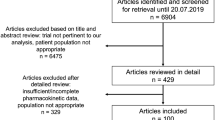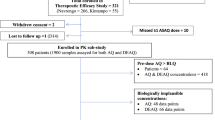Abstract
Despite increases in the incidence of many parasitic infections in recent years, the number of studies designed to improve the treatment of these infections has failed to keep pace with their huge impact on public health. Unfortunately, research and development in this field is not an economically attractive proposition for the pharmaceutical industry, and this neglect is exacerbated by the fact that many parasitic diseases have negligible profiles in countries that have the funds to research them. An absence of effective vaccines means that, for the foreseeable future, chemotherapy is likely to be the mainstay of disease management. This review describes the advances gained in our understanding of the relationship between pharmacokinetics and pharmacodynamics, with the aim of improving the way in which we use antiparasitic agents while at the same time highlighting those areas where there is an urgent need for further investigation. Unsurprisingly, much of our success has been in the chemotherapy of malaria, where the link between drug concentration and response is reasonably well characterised. For many other diseases, however, this link is poorly understood, in some cases because the mechanism of action of the drug has not been fully elucidated, or in other cases because a true pharmacodynamic endpoint may be unavailable. Overcoming these problems is critical if the clinician is to have the information necessary to enable optimal treatment of patients who may be severely ill and in need of immediate, life-saving attention.


Similar content being viewed by others
References
Stephenson LS, Latham MC, Ottesen EA (2000) Malnutrition and parasitic helminth infections. Parasitology 121 (Suppl):S23–S38
Stich AH, Abel P, Krishna S (2002) Human African trypanasomiasis. Brit Med J 325:203–206
Stich AH, Barrett M, Krishna S (2003) Waking up to sleeping sickness. Parasitol Today 19:195–197
White NJ (1999) Antimalarial drug resistance and combination chemotherapy. Phil Trans R Soc Lond B 354:739–749
Gardner MJ, Hall N, Fung E, White O, Berriman M, Hyman RW, Carlton JM, Pain A, Nelson KE, Bowman S, Paulsen IT, et al (2002) Genome sequence of the human malaria parasite Plasmodium falciparum. Nature 419:498–511
Missinou MA, Borrmann S, Schindler A, Issifou S, Adegnika AA, Matsiegui PB, Binder R, Lell B, Wiesner J, Baranek T, Jomaa H, Kremsner PG (2002) Fosmidomycin for malaria. Lancet 360:1941–1942
Ridley RG (2002) Medical need, scientific opportunity and the drive for antimalarial drugs. Nature 415:686–693
Evans WE, McLeod HL (2003) Pharmacogenomics—drug disposition, drug targets, and side effects. N Engl J Med 348:538–549
Weinshilboum R (2003) Inheritance and drug response. N Engl J Med 348:529–537
Krishna S, Planche T, Agbenyega T, Woodrow C, Agranoff D, Bedu-Addo G, Owusu-Ofori AK, Appiah JA, Ramanathan S, Mansor SM, Navaratnam V (2001) Bioavailability and preliminary clinical efficacy of intrarectal artesunate in Ghanaian children with moderate malaria. Antimicrob Agents Chemother 45:509–516
Edwards G, Winstanley PA, Ward SA (1994) Clinical pharmacokinetics in the treatment of tropical disease: some applications and limitations. Clin Pharmacokinet 27:150–165
Supanaranond W, Davis TME, Pukrittayakamee S, Silamut K, Karbwang J, Molunto P, Chanond, L, White NJ (1991) Disposition of oral quinine in acute falciparum malaria Eur J Clin Pharmacol 40:49–52
Watt G, White NJ, Padre L, Ritter W, Fernando MT, Ranoa CP, Laughlin LW (1998) Praziquantel pharmacokinetics and side effects in Schistosoma japonicum-infected patients with liver disease J Infect Dis 157:530–535
Field JW, Sandosham AA, Yap LF (1963) Technical miscellanea. The microscopical diagnosis of human malaria. I. A morphological study of the erythrocytic parasites in thick blood films, 2nd edn. Institute of Medical Research, Federation of Malaya, Kuala Lumpur
Field JW, Shute PG (1956) The microscopic diagnosis of human malaria—a morphological study of the erythrocytic parasite. Government Press, Kuala Lumpur
White NJ, Krishna S (1989) Treatment of malaria: some considerations and limitations of current methods of assessment. Trans R Soc Trop Med Hyg 83:767–777
Planche T, Krishna S, Kombila M, Engel K, Faucher J, Ngou-Milama E, Kremsner P (2001) A comparison of laboratory methods for the assessment of children with malaria. Am J Trop Med Hyg 65:599–602
Chiodini P (2003) Babesiosis. In: Cook G, Zumla A (eds) Manson’s tropical diseases, 21st edn, vol. 1. Elsevier Science, pp 1297–1301
Krishna S, Waller D, Kuile F ter, Kwiatkowski D, Crawley J, Craddock CFC, Nosten F, ChapmanD, Brewster D, Holloway PA, White NJ (1994) Lactic acidosis and hypoglycaemia in children with severe malaria: pathophysiological and prognostic significance. Trans R Soc Trop Med Hyg 88:67–73
Silamut K, White NJ (1993) Relation of the stage of parasite development in the peripheral blood to prognosis in severe malaria. Trans R Soc Trop Med Hyg 87:436–443
Amodu OK, Adeyemo AA, Olumese PE, Gbadegesin RA (1998) Intraleucocytic malaria pigment and clinical severity of malaria in children. Trans R Soc Trop Med Hyg 92:54–56
Metzger WG, Mordmüller BG, Kremsner PG (1995) Malaria pigment in leucocytes. Trans R Soc Trop Med Hyg 89:637–638
Phu NH, Day N, Diep PT, Ferguson DJP, White NJ (1995) Intraleucocytic malaria pigment and prognosis in severe malaria. Trans R Soc Trop Med Hyg 89:200–204
Braun-Munzinger RA, Southgate BA (1992) Repeatability and reproducibility of egg counts of Schistosoma haematobium in urine. Trop Med Parasitol 43:149–154
Cheever AW, Kamel IA, Elwi AM, Mosimann JE, Danner R (1997) Schistosoma mansoni and S. haematobium infections in Egypt. II. Quantitative parasitological findings at necropsy. Am J Trop Med Hyg 26:702–716
Pepin J, Milord F, Guern C, Mpia B, Ethier L, Mansinsa D (1989) Trial of prednisolone for prevention of melarsoprol-induced encephalopathy in Gambiense sleeping sickness. Lancet i:1246–1250
Cooper PJ, Guderian RH, Prakash D, Remick DG, Espine I, Nutman TB, Taylor DW, Griffin GE (1996) RANTES in onchocerciasis: changes with ivermectin treatment. Clin Exp Immunol 106:462–467
Pukrittayakamee S, Chantra A, Simpson JA, Vanijanonta S, Clemens R, Looareesuwan S, White NJ (2000) Therapeutic responses to different antimalarial drugs in vivax malaria. Antimicrob Agents Chemother 44:1680–1685
White NJ (2002) The assessment of antimalarial drug efficacy. Trends Parasitol 18:458–464
Day NP, Pham TD, Phan TL, Dinh XS, Pham PL, Ly VC, Tran TH, Nguyen TH, Bethell DB, Nguyan HP, Tran TH, White NJ (1996) Clearance kinetics of parasites and pigment-containing leukocytes in severe malaria. Blood 88:4694–4700
White NJ (1997) Assessment of the pharmacodynamic properties of antimalarial drugs in vivo. Antimicrob Agents Chemother 41:1413–1422
Kuile FO ter, White NJ, Holloway PA, Pasvol G, Krishna S (1993) Plasmodium falciparum: In vitro studies of the pharmacodynamic properties of antimalarials used for the treatment of severe malaria. Exp Parasitol 76:85–95
Watt G, Shanks GD, Phintuyothin P (1992) Prognostic significance of rises in parasitaemia during treatment of falciparum malaria. Trans R Soc Trop Med Hyg 86:359–360
Nealon C, Dzeing A, Muller-Romer U, Planche T, Sinou V, Kombila M, Kremsner PG, Parzy D, Krishna S (2002) Intramuscular bioavailability and clinical efficacy of artesunate in Gabonese children with severe malaria. Antimicrob Agents Chemother 6:3933–3939
Burri C, Baltz T, Giroud C, Doua F, Welker HA, Brun R (1993) Pharmacokinetic properties of the trypanocidal drug melarsoprol. Chemotherapy 39:225–234
Burri C, Nkunku S, Merolle A, Smith T, Blum J, Brun R (2000) Efficacy of new, concise schedule for melarsoprol in treatment of sleeping sickness caused by Trypanosoma brucei gambiense: a randomised trial. Lancet 355:1419–1425
Awadzi K, Adjepon-Yamoah KK, Edwards G, Orme ML’E, Breckenridge AM, Gilles HM (1996) The effect of moderate urine alkalinisation on low-dose diethylcarbamazine therapy in patients with onchocerciasis. Br J Clin Pharmacol 21:669–676
Edwards G, Dingsdale A, Helsby NA, Orme ML’E, Breckenridge AM (1988) Relative systemic availability of ivermectin after administration as capsule, tablet and oral solution. Eur J Clin Pharmacol 35:681–684
Fidock DA, Nomura T, Talley AK, Cooper RA, Dzekunov SM, Ferdig MT, Ursos LM, Sidhu B, Naude B, Deitsch KW, Su XZ, Wootton JC, Roepe PD, Wellems TE (2000) Mutations in the P. falciparum digestive vacuole transmembrane protein PfCRT and evidence for their role in chloroquine resistance. Mol Cell 6:861–871
Djimde A, Doumbo OK, Cortese JF, Kayentao K, Doumbo S, Diourte Y, Dicko A, Su XZ, Nomura T, Fidock DA, Wellems TE, Plowe CV, Coulibaly D (2001) A molecular marker for chloroquine-resistant falciparum malaria. N Engl J Med 344:257–263
Price R, Cassar CA, Brockman A, Duraisingh M, van Vugt M, White NJ, Nosten F, Krishna S (1999) Pfmdr1 gene amplification and multidrug-resistant Plasmodium falciparum on the north west border of Thailand. Antimicrob Agents Chemother 43:2943–2949
Doenhoff MJ, Kusel JR, Coles GC, Cioli D (2002) Resistance of Schistosoma mansoni to praziquantel: is there a problem? Trans R Soc Trop Med Hyg 96:465–469
Dull HB (1990) Mectizan donation and the Mectizan Expert Committee. Acta Leiden 59:399–403
Awadzi K (1993) Drug surveillance: international cooperation past, present and future. In: Proceedings of the XXVIIth CIOMS (Council for International Organisation of Medical Sciences) Confererence, Geneva,14–15 September 1993, pp 36–140
World Health Organisation (1995) Onchocerciasis and its control. Report of a WHO expert committee on onchocerciasis control. Tech Report Ser 852:1–104
Price RN, Nosten F, Luxemburger C, Kuile F ter, Paiphun L, Chongsuphajaisiddhi T, White NJ (1996) The effects of artemisinin derivatives on malaria transmissibility. Lancet 347:1654–1658
Kremsner PG, Krishna S (2002) Antimalarial cocktails—tropical flavours of the month. Lancet 360:1998–1999
Ezzet F, Vugt M van, Nosten F, Looareesuwan S, White NJ (2000) The pharmacokinetics and pharmacodynamics of lumefantrine (benflumetol) in acute uncomplicated falciparum malaria. Antimicrob Agents Chemother 44:697–704
Vugt M van, Brockman A, Gemperli B, Luxemburger C, Gathman I, Royce C, Slight T, Looareesuwan S, White NJ, Nosten F (1998) Randomised comparison of artemether-benflumetol and artesunate-mefloquine in the treatment of multi-drug resistant falciparum malaria. Antimicrob Agents Chemother 42:135–139
Aarons L (1993) Sparse data analysis. Eur J Drug Metab Pharmacokinet 18:97–100
Simpson JA, Aarons L, White NJ (2001) How can we do pharmacokinetic studies in the tropics? Trans R Soc Trop Med Hyg 95:347–351
Vozeh S, Steimer JL, Rowland M, Morselli P, Mentre F, Balant LP, Aarons L (1996) The use of population pharmacokinetics in drug development. Clin Pharmacokinet 30:81–93
Simpson JA, Price R, Kuile F ter, Teja-Isavatharm P, Nosten F, Chongsuphajaisiddhi T, Looareesuwan S, Aarons L, White NJ (1999) Population pharmacokinetics of mefloquine in patients with acute falciparum malaria. Clin Pharmacol Ther 66:472–484
Krishna S, Nagaraja NV, Planche T, Agbenyega T, Bedo-Addo G, Ansong D, Owusu-Ofori A, Shroads AL, Henderson G, Hutson A, Derendorf H, Stacpoole PW (2001) Population pharmacokinetics of intramuscular quinine in children with severe malaria. Antimicrob Agents Chemother 245:1803–1809
Author information
Authors and Affiliations
Corresponding author
Rights and permissions
About this article
Cite this article
Edwards, G., Krishna, S. Pharmacokinetic and Pharmacodynamic Issues in the Treatment of Parasitic Infections. Eur J Clin Microbiol Infect Dis 23, 233–242 (2004). https://doi.org/10.1007/s10096-004-1113-9
Published:
Issue Date:
DOI: https://doi.org/10.1007/s10096-004-1113-9




